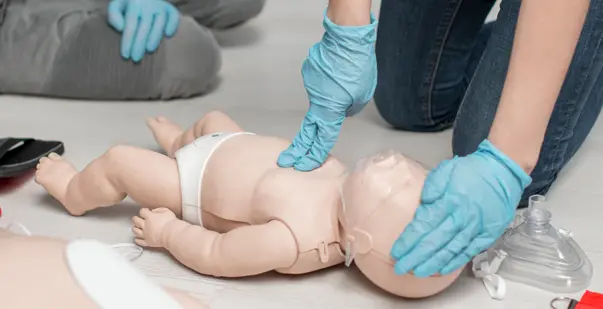
Last Updated On: noviembre 14, 2024
As a parent or caregiver, one of the scariest things that can happen is when a baby stops breathing. If you ever find yourself in this situation, it’s important to know how to take quick action and save your baby’s life.
Infant CPR is a life-saving skill that everyone who takes care of babies should learn. A key part of infant CPR is understanding the infant CPR ratio, which is the number of chest compressions to rescue breaths you should give.
In this guide, we’ll go over everything you need to know about infant CPR ratios. We’ll discuss the difference between one-rescuer and two-rescuer CPR, common mistakes people make, and why it’s so important to get trained.
If you’re the only person around to help a baby who isn’t breathing, you’ll need to use the 1 rescuer infant CPR ratio. The American Heart Association says this ratio is 30 chest compressions to 2 rescue breaths. Here’s what that means:
To start CPR, check for a pulse on the side of the child’s neck (carotid artery) or the inner thigh (femoral artery) for no more than 10 seconds. If there is no pulse or the pulse is less than 60 beats per minute with signs of poor perfusions, such as pale or bluish skin, begin chest compressions.
To do chest compressions:
The 1 person infant CPR ratio is the same as the 1-rescuer ratio. When you are alone, you will first examine the baby’s brachial pulse for a minimum of 5 seconds and a maximum of 10 seconds. Then, follow these steps:
The infant CPR compression to breath ratio is an important part of doing CPR the right way. As we’ve talked about, the ratio for one-rescuer infant CPR is 30 chest compressions to 2 rescue breaths (30:2). This helps make sure the baby gets enough compressions to keep their blood flowing and enough breaths to get oxygen.
It’s important to know that the ratio for infants is different than for adults and older children. For adults and kids, the ratio is 30:2 for one-rescuer CPR and 15:2 for two-rescuer CPR.
A common question people have is, what ratio of compressions to breaths should be used for 1-rescuer infant CPR? The answer is 30 chest compressions to 2 rescue breaths (30:2).
By using this 30:2 ratio, one person can give effective CPR to a baby and give them the best chance of surviving until more advanced medical help arrives. If you’re learning infant CPR for the first time, your instructor will have you practice the 30:2 ratio on a baby manikin. You’ll do 30 chest compressions and 2 rescue breaths repeatedly until you feel comfortable and confident with the technique.
In a situation where two people are available to perform CPR, you can use the infant CPR ratio 2 rescuer method. This means one person does chest compressions while the other gives rescue breaths. For two-rescuer infant CPR, the ratio is 15 chest compressions to 2 rescue breaths (15:2).
Having two rescuers allows for a more efficient and effective CPR process. The rescuer performing chest compressions can maintain a consistent rhythm without stopping for rescue breaths, while the second rescuer focuses on providing effective ventilation. This teamwork approach can lead to better outcomes for the infant.
To perform two-rescuer infant CPR, the rescuer giving compressions should use the two-thumb encircling technique.
When it comes to performing CPR on an infant, the approach differs slightly based on whether there is one rescuer or two. Knowing these key differences can make a significant impact in an emergency:
| Aspect | 1 Rescuer Infant CPR | 2 Rescuer Infant CPR |
|---|---|---|
| Infant CPR Compression to Breath Ratio | 30:2 | 15:2 |
| Compression Technique | Two fingers in the center of the chest, below the nipple line | Both thumbs encircling the chest with fingers supporting the back |
| Compression Depth | About 1.5 inches (4 cm) | About 1.5 inches (4 cm) |
| Compression Rate | 100-120 per minute | 100-120 per minute |
| Breath Technique | 2 gentle breaths after every 30 compressions | 2 gentle breaths after every 15 compressions |
| Rescuer’s Position | Kneel beside the infant or position comfortably | One rescuer performs compressions from the head, the other provides breaths from the side |
| Benefits | Can be performed solo | Allows for quicker cycles and reduced rescuer fatigue, better coordination |
1 rescuer infant CPR ratio requires alternating between compressions and breaths, which can be physically demanding and may lead to fatigue. In contrast, tasks are divided in two-rescuer infant CPR. This approach enables a more consistent and efficient CPR process, as each rescuer focuses on their specific role without interruption.
Doing CPR on a baby can be scary, and it’s easy to make mistakes, especially if you’re not trained. Some common mistakes to avoid while performing infant CPR include:
Incorrect Rescue Breath Technique: Delivering rescue breaths that are too forceful or too shallow can be ineffective or harmful. Give gentle breaths, watching for the chest to rise and fall.
Knowing the right infant CPR ratio is an important skill for anyone who spends time with babies. Whether you’re using the one-rescuer or two-rescuer method, the compression-to-breath ratios are key to giving effective CPR.
Remember, 1 rescuer infant CPR ratio is 30 chest compressions to 2 rescue breaths (30:2). For two-rescuer CPR, the ratio is 15 compressions to 2 breaths (15:2). Getting trained in infant CPR and practicing regularly can help you feel more confident and prepared.
Don’t wait for an emergency to happen before you learn these life-saving skills. Find a CPR class near you and get trained as soon as you can. By learning infant CPR, you’re giving yourself the power to save a baby’s life when it matters most.
Read more: The Benefits of Online CPR Training: Convenience and Flexibility